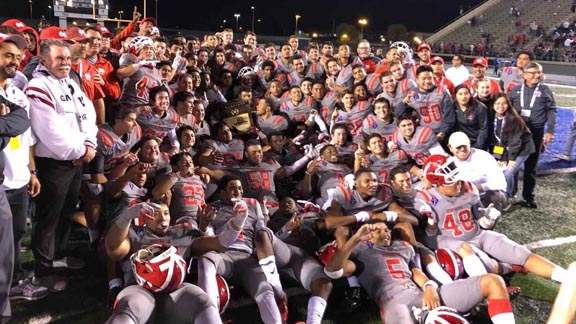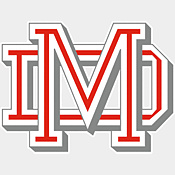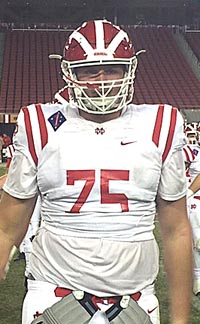
Mater Dei players and coaches get their photo taken following win against St. John Bosco for CIF Southern Section D1 championship. Photo: AngelusNews.com / Mater Dei HS.
For the third time in its history, but second year in a row, Mater Dei of Santa Ana collects State Team of the Year honor in California prep football. Read more for why this year’s Monarchs reminds us of the school’s and head coach Bruce Rollinson’s very first CIF Southern Section championship squad.
We hope you enjoy this free feature. This is a great time to sign up for our Gold Club to see all of our great content, including final, expanded State Top 50 teams also coming this week. Some of the all-state football teams also will be Gold Club, including All-State Juniors and All-State Sophomores. You can get it for just $9.99 to check it out for three months. For details, CLICK HERE.
The 127th State Team of the Year for California high school football is a selection that has been a foregone conclusion since Saturday night, December 8, but this week it can now be made official.
On that night, Mater Dei of Santa Ana repeated as the CIF Open Division state champion with a 35-21 victory over 18-time State Team of the Year De La Salle (Concord). Head coach Bruce Rollinson’s team still had to wait until all games were played in the state for the choice to become official since the CIF Open Division state final was played one week prior to most of the other CIF state championship games.

The Monarchs (14-1*), who avenged their only loss on the field (which came in October to St. John Bosco of Bellflower) with a 17-13 triumph vs. the Braves in the CIF Southern Section D1 final, also got good news over the weekend when Allen of Texas lost in that state’s semifinals. If Allen had won its state title and finished unbeaten, there would be at least one and perhaps more of the various final national rankings that would have ranked Allen first and Mater Dei second. Mater Dei already was first in some of the national polls. Instead, for the second straight year, it will be a unanimous sweep of major No. 1 national rankings.
Although this year’s team wasn’t as dominant in several positions as last year’s unbeaten Monarchs, Rollinson talked often about its resiliency to overcome injuries and how it rebounded from the one loss to St. John Bosco. When the Monarchs won in their rematch vs. the Braves, it was Bosco that was the consensus No. 1 team in the nation.
Offensively, Mater Dei didn’t miss a beat with Cathedral of Los Angeles transfer Bryce Young taking over at quarterback from JT Daniels, who quickly became a starter at USC. Amon Ra-St. Brown’s graduation departure at receiver was filled primarily with five-star athlete Bru McCoy. There also was great depth at running back with Shakobe Harper and Sean Dollars both showing game-breaking skills on any play. The defense pitched a shutout of national power Bishop Gorman of Las Vegas, helped slug out a 24-21 win vs. IMG Academy of Florida and held De La Salle to negative yards rushing in that state final. The defense also had four pick six TDs in one half of the game vs. Corona Centennial with three of those coming by super junior corner Elias Ricks.
Overcoming a regular season loss and knocking off a No. 1 team in the nation to finish as State Team of the Year is a path that Mater Dei has taken before. In much the same way that De La Salle’s 1992 team set the tone for that program for many years to come, the 1991 Monarchs did the same for Rollinson.
We saw the Monarchs in 1991 play a game in Hawaii and we also were there when they bounced back from a 28-20 loss to Loyola of Los Angeles to post a 24-6 victory on the road at Bishop Amat of La Puente that turned the season around. Mater Dei later avenged the loss to Loyola with a 35-21 win in the CIFSS top division semifinals and faced unbeaten and No. 1 ranked Eisenhower of Rialto in the championship.
That 1991 CIFSS title game at Anaheim Stadium drew more than 33,000 fans, many of whom were there because of Eisenhower’s prominence in the national rankings. There also weren’t nearly as many national polls as there are today and keep in mind that Mater Dei was only in its third year with Rollinson as head coach. The first two teams under Rollinson were only 7-5 and 7-6 so it wasn’t even close to what people have come to expect when the three-stripers hit the field now.
On that night, though, it all came together for the Monarchs. Sure, Eisenhower helped by fumbling away the ball three times, but senior quarterback Billy Blanton passed for 257 yards and three TDs. There also was a 49-yard flea flicker TD pass to David Knuff and a 63-yard interception return by Brian Barajas.
It legitimately could be argued that 1991 set the bar high for all of Rollinson’s future teams. By 1994 and 1996, Mater Dei had its first two USA Today title teams (the Monarchs weren’t State Team of the Year either time in favor of De La Salle, which even by then was beginning to threaten the national win streak record). The 1998 team lost to De La Salle, then won the CIFSS title by defeating Long Beach Poly on another memorable night at the stadium.
Last year’s Monarchs may eventually go down as one of the three or four greatest in state history or even No. 1. Comparing any group to that one might not be fair, but this year’s team did it in its own way and is equally deserving of being the 2018 State Team of the Year.
Congratulations to all the players and coaches.
CAL-HI SPORTS STATE
TEAMS OF THE YEAR
ALL-TIME HONOR ROLL
(Last 117 years listed, but it goes back further than that to 1891 in our files, as compiled from 1891 to 2003 by the late Nelson Tennis)

Tommy Brown was dominating tackle on Mater Dei’s No. 1 team from 2017. Photo: Mark Tennis.
2018 — Santa Ana Mater Dei (14-1*)
2017 — Santa Ana Mater Dei (15-0)
2016 — Bellflower St. John Bosco (13-2)
2015 — Concord De La Salle (13-1)
2014 — Concord De La Salle (15-0)
2013 — Bellflower St. John Bosco (16-0)
2012 — Concord De La Salle (15-0)
2011 — Concord De La Salle (13-1)
2010 — Concord De La Salle (14-0)
2009 — Concord De La Salle (13-2)
2008 — Corona Centennial (15-0)
2007 — Concord De La Salle (13-0)
2006 — Westlake Village Oaks Christian (15-0)
2005 — Ventura St. Bonaventure (14-0)
2004 — Mission Viejo (14-0)
2003 — Concord De La Salle (13-0)
2002 — Concord De La Salle (13-0)
2001 — Concord De La Salle (12-0)
2000 — Concord De La Salle (13-0)
1999 — Concord De La Salle (12-0)
1998 — Concord De La Salle (12-0)
1997 — Concord De La Salle (12-0)
1996 — Concord De La Salle (12-0)
1995 — Concord De La Salle (13-0)
1994 — Concord De La Salle (13-0)
1993 — Rialto Eisenhower (14-0)
1992 — Concord De La Salle (13-0)
1991 — Santa Ana Mater Dei (13-1)
1990 — Merced (14-0)
1989 — Fontana (14-0)
1988 — Carson (12-1)
1987 — Fontana (14-0)
1986 — El Toro (14-0)
1985 — Vista (13-0)
1984 — Riverside Poly (13-1)
1983 — Mountain View St. Francis (13-0)
1982 — Anaheim Servite (11-1)
1981 — San Jose Bellarmine (12-0)
1980 — Wilmington Banning (12-0)
1979 — Huntington Beach Edison (12-2)
1978 — Visalia Mt. Whitney (13-0)
1977 — Rancho Cordova (12-0)
1976 — Wilmington Banning (12-1)
1975 — Rancho Cordova (11-0)
1974 — Vista (13-0)
1973 — Hacienda Heights Los Altos (12-1)
1972 — Santa Fe Springs St. Paul (13-0)
1971 — Carson (12-0)
1970 — La Puente Bishop Amat (12-1)
1969 — Pasadena Blair (13-0)
1968 — Alameda (9-0)
1967 — Anaheim (12-1)
1966 — Pico Rivera El Rancho (13-0)
1965 — San Jose Bellarmine (9-0)
1964 — Stockton Stagg (10-0)
1963 — Los Angeles Loyola (12-0)
1962 — Los Angeles Loyola (12-0)
1961 — Monterey (8-0)
1960 — Redwood City Sequoia (9-0)
1959 — Long Beach Poly (11-0)
1958 — Long Beach Poly (11-0-1)
1957 — Berkeley (8-0)
1956 — Downey (12-0-1)
1955 — San Diego (11-0-1)
1954 — Vallejo (9-0)
1953 — Santa Monica (10-0-1)
1952 — Santa Monica (11-0-1)
1951 — Pomona (12-0)
1950 — Compton (11-1)
1949 — Compton (10-1)
1948 — Long Beach St. Anthony (11-1-1)
1947 — L.A. Washington (8-0)
1946 — Alhambra Keppel (8-0)
1945 — Santa Ana (11-1)
1944 — Alhambra Keppel (8-0)
1943 — Redondo Beach Redondo (6-0)
1942 — La Verne Bonita (11-0)
1941 — Piedmont (9-0)
1940 — Piedmont (8-0)
1939 — Alhambra (10-0)
1938 — Stockton (8-0)
1937 — L.A. Manual Arts (8-0)
1936 — L.A. Manual Arts (8-0-1)
1935 — Long Beach Poly (9-0)
1934 — Piedmont (8-0)
1933 — S.F. Galileo (8-2-1)
1932 — Inglewood (10-2)
1931 — Santa Ana (13-0)
1930 — Berkeley (11-0-1)
1929 — Berkeley (11-0-1)
1928 — Lodi (9-0)
1927 — Bakersfield (12-0)
1926 — San Mateo (9-1-1)
1925 — Los Angeles (10-0)
1924 — Berkeley (11-0)
1923 — Bakersfield (10-0-1)
1922 — Bakersfield (10-0-1)
1921 — Bakersfield (9-0-1)
1920 — Bakersfield (9-1)
1919 — Long Beach Poly (12-0)
1918 — L.A. Manual Arts (9-0)
1917 — L.A. Manual Arts (11-1)
1916 — San Diego (12-0)
1915 — Pasadena (7-1)
1914 — Pomona Rugby (12-0)
1913 — Pomona Rugby (11-0)
1912 — Berkeley Rugby (7-2-1)
1911 — Los Angeles Rugby (9-0)
1910 — Alameda (5-0)
1909 — Los Angeles Poly Rugby (8-0-2)
1908 — Belmont Academy (8-0-1)
1907 — Los Angeles (5-1)
1906 — Belmont Academy (5-0)
1905 — Berkeley (5-1-3)
1904 — Belmont Academy (1-0-1)
1903 — Belmont Academy (5-1)
1902 — Belmont Academy (4-0-2)
1901 — Belmont Academy (3-2)
1900 — San Francisco Lowell (5-1-2)
Corrections or comments? Email markjtennis@gmail.com.
Mark Tennis is the co-founder and publisher of CalHiSports.com. He can be reached at markjtennis@gmail.com. Don’t forget to follow Mark on the Cal-Hi Sports Twitter handle: @CalHiSports





3 Comments
Quick observation for TOY…and before I state my comment, well done to MD again.
I noticed you state that the TOY is driven by whoever wins the Open, which to some level makes sense. But I would like to make an observation as well as a counter suggestion.
As far as the observation, I noticed that the only team who won the Open and not win TOY is Grant in 2008. I understand you have stated that in your view Centennial was higher ranked than LBP. However, some publications had LBP as high as 2 nationally. Additionally, by your own criteria, Grant won the Open and should have been name TOY. Additionally, what Grant accomplished that year by beating two State champions out of state, as well as putting Sacramento football on the map, was greater than the fact that Centennial beat DLS. It is only right to use your own yard stick to give Grant TOY for 2008 – but yet the only SJS/Sac area team to win the Open does not get TOY, which to me seems like some level of bias (no disrespect, simply observation). I think Grant was slighted, based simply on your own criteria not to mention what they did and the shock win over LBP. I would make a bet that if DLS had beaten LBP in the open (and DLS had 1 or 2 losses that year) and Grant beat Centennial, you would have crowned DLS the TOY. So as a SJS fan (Folsom most specifically), I am frustrated.
Additionally, I think the TOY should really be based upon what team not only won a state championship but did so in a very unique or monumental way. This would allow smaller schools to be eligible should their season be historic. Most years it should go to the Open winner, but crazy teams like 2008 Grant, 2014 Folsom, 2015 Palo Alto (is that correct year), or some small school this year could win.
Yes, there are years where a team may have done something more inspirational or may have had a breakthrough of some kind that might be more deserving of being State Team of the Year. But since Nelson started doing all of these lists in the 1970s, State Team of the Year in all sports just goes to the team that should be No. 1 in final rankings or is just evaluated as being the best. We’re certainly not going to go through everything and make changes now. How does that make sense to treat previous State Teams of the Year to remove them? We never ranked Grant 2008 ahead of De La Salle because we weren’t snookered like a few of the section commissioners about wins over state title teams from those powerhouse states of Idaho and Utah. And that year Centennial was ahead of LB Poly too.
To be political max preps just named a school in Texas that didn’t play an out of state opponent, as the national champ. LOL!!